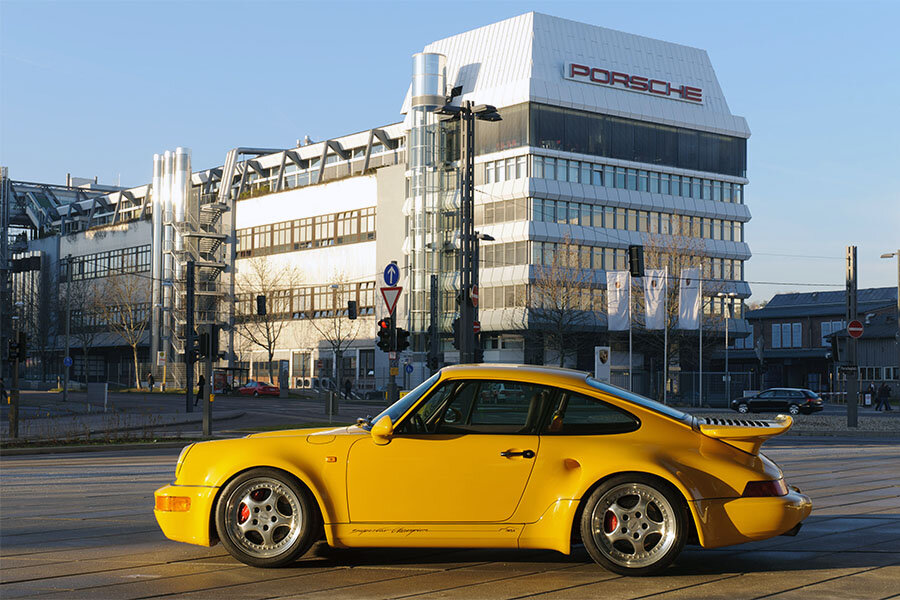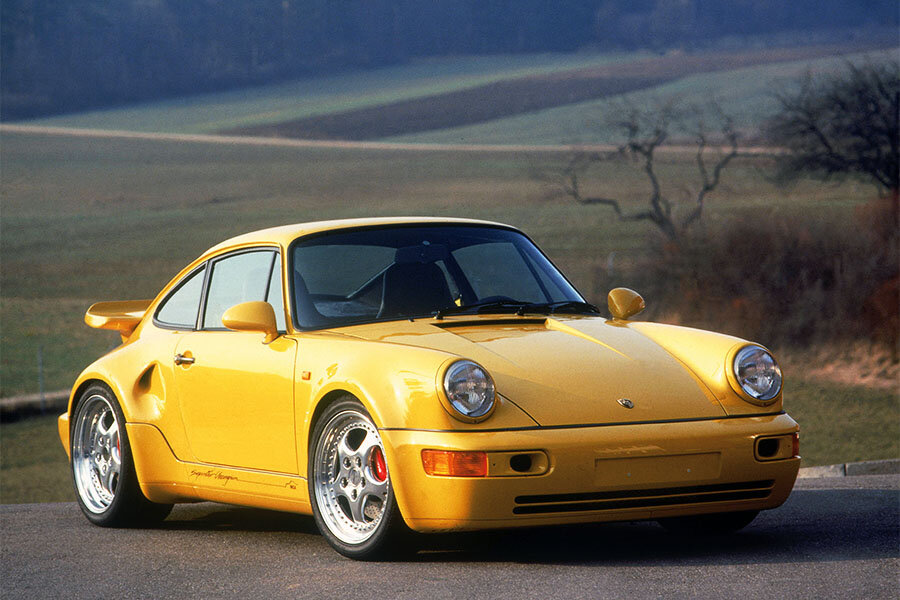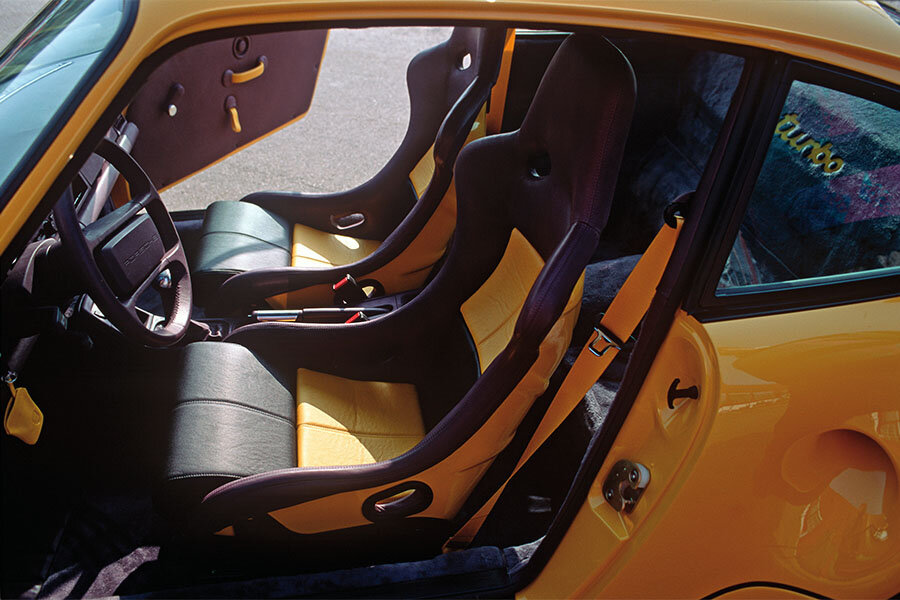Guide: Porsche 911 3.3 Turbo S Lightweight (964) - a Historical & Technical Appraisal
/BACKGROUND
Although the 964 range looked like it had been given little more than a facelift compared to its predecessors, Porsche had actually invested heavily to improve this new line of 911s.
Most notably, the 964 ushered in a revised suspension arrangement that did away with torsion bars in favour of coil sprung dampers. The brakes and engine were also substantially modified.
First of the 964s to arrive was a new four-wheel drive variant, the Carrera 4 Coupe, in August 1989. This was followed a few months later by a rear-wheel drive variant (the Carrera 2) along with a choice of Cabriolet and Targa body styles.
In September 1990, Porsche began production of a turbocharged variant that was available only as a Coupe.
At the Geneva Motor Show in March 1991, the fabled Carrera RS moniker returned to the 911 range. Last seen in the mid 1970s, like its forbears, this latest iteration of the legendary variant was a stripped out, high performance lightweight created for Porsche customers that wanted a hardcore driving experience and little in the way of creature comforts.
Unfortunately, the early 1990s proved a challenging time for Porsche.
The worldwide economy was in a tailspin and poor trading conditions were not helped by what was perceived to be an outdated range. Years of over trading and an image closely associated with the brash consumerism of the 1980s further exacerbated the problem.
To illustrate just how bad things were for Porsche, annual sales had shrunk by around two thirds. The short-term outlook for the company was bleak and there was little hope of a quick turnaround.
Against this backdrop, in January 1992, the head of Porsche’s Exclusive department, Rolf Sprenger, pitched the idea of a souped up 911 Turbo with the back-to-basics appointments of the Carrera RS.
Since its launch, the Carrera RS had proven to be the one 964 model that had sold better than anticipated. The proposed new model would satisfy those customers who simply wanted the ultimate 911 that money could buy.
Having got the nod from management, Sprenger’s team prepared a prototype for the Geneva Motor Show in March 1992.
The bright yellow machine was well received and, in May 1992, a limited run of 80 vehicles was sanctioned.
Dubbed 911 Turbo S Lightweight, the new forced induction hot rod was the first car developed entirely by Porsche Exclusive (formerly the Special Wish or Sonderwunsch department).
Although not conceived with competition in mind, it would ultimately serve as the platform to homologate the 964 Turbo S LM racing car of 1993.
CHASSIS
As per the Carrera RS, the Turbo S Lightweight was based around a seam-welded bodyshell that featured a reinforced floor along with strengthened mounts for the rear suspension, transmission and anti-roll bars.
Underseal was kept to a minimum.
Like every 964, the suspension layout comprised a MacPherson strut arrangement at the front with cast-aluminium semi-trailing arms at the back.
The Turbo S Lightweight imported the progressive rate springs, Bilstein dampers, aluminium instead of steel hubs and the front strut brace from the RS. Similarly, there were ball joints for the upper spring strut mounts, hard rubber lower control arm bushings and modified trailing arm mounts at the rear.
Compared to the regular Turbo, ride height was 40mm lower and thicker anti-roll bars were installed. The power steering system was removed.
In addition to the suspension, the brake system also came from the RS. Cross-drilled and ventilated discs of 322mm were fitted at the front. Those at the back measured 299mm. The Anti-lock Brake System was re-calibrated compared to regular 964s and a hydraulic instead of vacuum servo was fitted along with a bigger master cylinder.
Uniquely, the Turbo S Lightweight calipers were normally painted red (a first for Porsche).
Another of the car’s special features was its handsome three-piece Speedline magnesium wheels. At 8 x 18-inches front and 10 x 18-inches rear they were an inch taller and an inch wider than the standard Turbo rims. Pirelli P Zero tyres were fitted.
Like the RS, a long-range 92-litre fuel tank was installed underneath the front lid.
ENGINE / TRANSMISSION
In the engine bay was a specially prepared version of the 3.3-litre all-alloy, single overhead camshaft, two valve per cylinder Flat 6 used by the regular forced induction 964. As usual, dry-sump lubrication was employed along with a 7.0:1 compression ratio and Bosh Motronic engine management.
Displacement remained at 3299cc thanks to a bore and stroke of 97mm and 74.4mm respectively.
Special equipment found on the Type M30/69 SL motor included bigger fuel injectors, enlarged inlet and exhaust ports, a new inlet manifold, more aggressive camshafts and different valve timing. There was also a more efficient KKK turbocharger with increased boost pressure.
The SL motor was visually identifiable by virtue of its red-painted intercooler housing and air filter unit.
The power output went from 320bhp at 5750rpm to 381bhp at 6000rpm. The torque rating was now 361lb-ft at 4800rpm compared to 347lb-ft at 4500rpm.
Transmission was once again via the G50/52 five-speed gearbox, a single-plate clutch and limited-slip differential.
BODYWORK
Cosmetically, the Turbo S Lightweight took the butch, wide-arched look of the standard forced induction model and added a few custom touches.
At the front, the fog lights were deleted in favour of intakes that fed cool air to the oil cooler and brakes.
The rear fenders were modified to incorporate a 959-style duct which channelled air to the rear brakes.
On the engine lid was a slim body coloured rear spoiler.
The lower sills and front apron were completely painted to match the rest of the body.
To further reduce weight, the front lid, engine cover and doors were fabricated from GRP-composite.
The standard 964 Turbo was already a very handsome car, but thanks to its special enhancements, the Lightweight ranked among the best looking air-cooled 911s of all time.
INTERIOR
Inside, as per the Carrera RS, Porsche stripped away much of the normal equipment and replaced it with an array of simplified parts.
To save weight, the rear seats were deleted and an Turbo S logo was embroidered on this newly carpeted section.
Thinner carpet was used throughout and most of the sound insulation was absent.
The front seats were switched to fibreglass Recaro buckets that offered manual fore / aft adjustment only. The seats were trimmed with leather and the centre panels were normally upholstered with coloured inserts.
Body coloured seatbelts were often fitted and mounting points for six-point harnesses were plumbed in.
The standard door panels with their armrests and storage bins were junked in favour of lightweight parts with simple handles and fabric looped pull chords .
Porsche also deleted the power-operated windows and mirrors, the central locking system, the alarm, the interior light and even the passenger sun visor. Gone too were the airbags.
Provision was made for a two speaker audio system.
Features unique to the new forced induction Lightweight included a three-spoke non-airbag steering wheel embossed with Turbo S insignia, Turbo S stitching on the carpeted rear quarters and thinner glass for the side and rear windwos.
OPTIONS
Although options were officially fairly limited, the Exclusive department could accommodate practically any demand.
Some owners requested the re-instatement of electric windows, an airbag steering wheel and an audio system.
Others went a few steps further and specified a roll cage, four-point Schroth harnesses, a fire extinguisher, coloured wheel centres and coloured instruments. A few cars had cockpits with practically every surface covered in coloured leather.
WEIGHT / PERFORMANCE
Whereas the standard 911 Turbo tipped the scales at 1470kg, the Lightweight came in at 1290kg which represented a reduction of 180kg.
Top speed went from 169mph to 183mph.
The 0-62mph time dropped to 4.7 seconds from 5 seconds flat.
This was easily the fastest 911 street car ever produced.
PRODUCTION
The prototype displayed at Geneva in 1992 (chassis WP0ZZZ96ZNS470612, depicted here) featured a number of differences to subsequent production versions. It came with a conventional four-spoke steering wheel, a carpeted rear section with standard Turbo stitching and IMSA Supercar Champion decals down each flank to celebrate Porsche’s victory in the Driver and Manufacturer categories of the 1991 IMSA Supercar championship.
Although Porsche planned to build 80 cars, 86 were eventually completed. Of these, eleven were supplied in right-hand drive.
As per the Carrera RS, the Turbo S Lightweight was originally outlawed from sale in the USA on safety and emissions grounds.
Text copyright: Supercar Nostalgia
Photo copyright: Porsche - https://www.porsche.com

































